
Fort Nepean
Encyclopedia
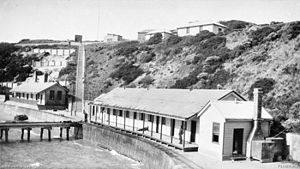
Point Nepean, Victoria
Point Nepean marks the southern point of The Rip and the most westerly point of the Mornington Peninsula, in Victoria, Australia. It was named after the British politician and colonial administrator, Sir Evan Nepean. It is within the suburb of Portsea...
, Victoria
Victoria (Australia)
Victoria is the second most populous state in Australia. Geographically the smallest mainland state, Victoria is bordered by New South Wales, South Australia, and Tasmania on Boundary Islet to the north, west and south respectively....
, Australia
Australia
Australia , officially the Commonwealth of Australia, is a country in the Southern Hemisphere comprising the mainland of the Australian continent, the island of Tasmania, and numerous smaller islands in the Indian and Pacific Oceans. It is the world's sixth-largest country by total area...
. It was part of a network of fortifications, commanded from Fort Queenscliff
Fort Queenscliff
Fort Queenscliff, in Victoria, Australia, dates from 1860 when an open battery was constructed on Shortland's Bluff to defend the entrance to Port Phillip. The Fort, which underwent major redevelopment in the late 1870s and 1880s, became the headquarters for an extensive chain of forts around Port...
, protecting the narrow entrance to Port Phillip
Port Phillip
Port Phillip Port Phillip Port Phillip (also commonly referred to as Port Phillip Bay or (locally) just The Bay, is a large bay in southern Victoria, Australia; it is the location of Melbourne. Geographically, the bay covers and the shore stretches roughly . Although it is extremely shallow for...
.
Background
Following the 1875–76 Royal CommissionRoyal Commission
In Commonwealth realms and other monarchies a Royal Commission is a major ad-hoc formal public inquiry into a defined issue. They have been held in various countries such as the United Kingdom, Australia, Canada, New Zealand, and Saudi Arabia...
into the Volunteer Forces, the Victorian Government invited the Director of Works and Fortifications in London
London
London is the capital city of :England and the :United Kingdom, the largest metropolitan area in the United Kingdom, and the largest urban zone in the European Union by most measures. Located on the River Thames, London has been a major settlement for two millennia, its history going back to its...
, Lieutenant General Sir William Jervois
William Jervois
Sir William Francis Drummond Jervois, GCMG, CB was a British military engineer who saw service, as Second Captain, in South Africa...
, to Victoria to further advise on Victoria's defences. He arrived in 1873 accompanied by the Colonel Scratchley. Their joint report recommended that the basic defences for the Colony should be concentrated on the Heads, and consist of fortifications at the entrance to the Bay and on the shoals between the main shipping channels.
Fortifications and guns
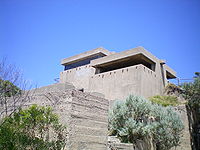
Gibraltar
Gibraltar is a British overseas territory located on the southern end of the Iberian Peninsula at the entrance of the Mediterranean. A peninsula with an area of , it has a northern border with Andalusia, Spain. The Rock of Gibraltar is the major landmark of the region...
". The barracks housed a Company of the Royal Victoria Volunteer Artillery Regiment.
1878–1880
The first coastal defence guns on the site were four 80 pounder Rifled Muzzle Loading guns in two temporary sandbagged batteries. These were moved into more substantial earth emplacements from 1880.1886–1890
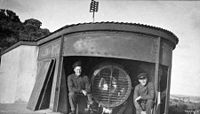
BL 6 inch gun Mk I - VI
The BL 6 inch guns Marks II, III, IV and VI were the second and subsequent generations of British 6-inch breechloading naval guns, designed by the Royal Gun Factory following the first 6-inch breechloader, the relatively unsuccessful BL 6 inch 80 pounder gun designed by Elswick Ordnance. They...
disappearing gun
Disappearing gun
A disappearing gun is a type of heavy artillery for which the gun carriage enabled the gun to rotate backwards and down into a pit protected by a wall or a bunker after it was fired...
s, two BL 9.2 inch (234 mm) Mk VI
BL 9.2 inch gun Mk I - VII
The BL 9.2 inch guns Mk I - Mk VII were a family of early British heavy breechloading naval and coast defence guns in service from 1881 to the end of World War I...
breech-loading 'counter bombardment' British Armstrong
Armstrong Gun
The term Armstrong Gun was primarily used to describe the unique design of the rifled breech-loading field and heavy guns designed by Sir William Armstrong and manufactured in England from 1855 by the Elswick Ordnance Company and the Royal Arsenal at Woolwich...
guns, a 4.7 inch quick firing (QF) gun
QF 4.7 inch Gun Mk I - IV
The QF 4.7 inch Gun Mks I, II, III, and IV were a family of United-Kingdom 120-mm naval and coast defence guns of 1888 and 1890s which served with the navies of various countries. They were also mounted on various wheeled carriages to provide the British Army with a long range gun...
and a QF 14 pounder
QF 14 pounder Maxim-Nordenfelt naval gun
The QF 14 pounder was a 3-inch medium-velocity naval gun used to equip warships for defence against torpedo boats. It was produced for export by Maxim-Nordenfelt in competition with the Elswick QF 12-pounder 12 cwt and QF 12-pounder 18 cwt guns.-Victorian Navy service:2 guns were mounted on HMVS...
. One of the former 80 pounder emplacements was used as an observation post and one new emplacement was used as an armourer's store.
Two of the same type of BL 9.2 inch (234 mm) Mk VI
BL 9.2 inch gun Mk I - VII
The BL 9.2 inch guns Mk I - Mk VII were a family of early British heavy breechloading naval and coast defence guns in service from 1881 to the end of World War I...
gun were installed at Fort Queenscliff
Fort Queenscliff
Fort Queenscliff, in Victoria, Australia, dates from 1860 when an open battery was constructed on Shortland's Bluff to defend the entrance to Port Phillip. The Fort, which underwent major redevelopment in the late 1870s and 1880s, became the headquarters for an extensive chain of forts around Port...
. One each of the guns was installed at Ben Buckler Gun Battery, Signal Hill Battery
Signal Hill Battery
The Signal Hill Battery was constructed in 1892-3 at Watsons Bay and is adjacent to the Signal Hill Lighthouse on Old South Head Road.-History and description:...
, and Steel Point Battery in Sydney
Sydney
Sydney is the most populous city in Australia and the state capital of New South Wales. Sydney is located on Australia's south-east coast of the Tasman Sea. As of June 2010, the greater metropolitan area had an approximate population of 4.6 million people...
. The barrel of the Signal Hill gun is on display at the Royal Australian Artillery Museum at North Fort, North Head, in Sydney. The Ben Buckler gun has been recovered and is awaiting restoration.
1907–1915
From 1911 the fort was manned by the newly renamed Royal Australian Garrison Artillery and the Royal Australian Engineers. With war in Europe looming, longer range 6 inch Mk VIIBL 6 inch Mk VII naval gun
The BL 6 inch Gun Mark VII was a British naval gun dating from 1899, which was mounted on a heavy traveling carriage in 1915 for British Army service to become one of the main heavy field guns in the First World War, and also served as one of the main coast defence guns throughout the British...
guns replaced the 9.2 inch guns. One of the 6 inch BL guns was removed and the 14 pounder was moved to Fort Queenscliff. The 4.7 inch QF gun was removed and the emplacement fitted with a searchlight, along with an engine house to generate electricity. The remaining gun emplacements were renumbered – the Mk VII guns were numbered A1 and B1, and the 6 inch BL guns numbered F1 and H1.
1939–1942
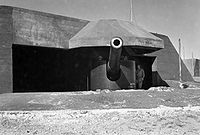
World Wars
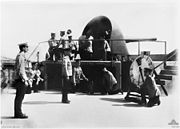

World War I
World War I , which was predominantly called the World War or the Great War from its occurrence until 1939, and the First World War or World War I thereafter, was a major war centred in Europe that began on 28 July 1914 and lasted until 11 November 1918...
and World War II
World War II
World War II, or the Second World War , was a global conflict lasting from 1939 to 1945, involving most of the world's nations—including all of the great powers—eventually forming two opposing military alliances: the Allies and the Axis...
were fired from Fort Nepean.
On 5 August 1914, the German ship SS Pfalz
SS Pfalz
The Pfalz was a 6,557 ton cargo steamer operated by German shipping company Norddeutscher Lloyd. The ship became the target of the first shot fired by Australian forces in World War I, soon after departing the Port of Melbourne in Australia....
attempted to escape Port Phillip
Port Phillip
Port Phillip Port Phillip Port Phillip (also commonly referred to as Port Phillip Bay or (locally) just The Bay, is a large bay in southern Victoria, Australia; it is the location of Melbourne. Geographically, the bay covers and the shore stretches roughly . Although it is extremely shallow for...
. Within minutes of being notified that war had been declared, Lieutenant-Colonel Sandford at Fort Queenscliff
Fort Queenscliff
Fort Queenscliff, in Victoria, Australia, dates from 1860 when an open battery was constructed on Shortland's Bluff to defend the entrance to Port Phillip. The Fort, which underwent major redevelopment in the late 1870s and 1880s, became the headquarters for an extensive chain of forts around Port...
gave an order to Lieutenant C Morris, the Fire Commander at Fort Nepean, to "stop her or sink her". After the Pfalz ignored signals to halt, the B1 gun fired across her bow. The Pfalz then turned around and the crew was arrested at Portsea
Portsea, Victoria
Portsea is a resort town located across Port Phillip from Melbourne, Victoria, Australia. Its Local Government Area is the Shire of Mornington Peninsula....
.
At 1.30am on 4 September 1939, within hours of war being declared, the A1 gun fired across the bow of a ship which failed to identify itself. The ship then identified as the Australian freighter SS Woniora.
These were the only occasions any of the Port Phillip batteries fired in anger.
After World War II
With the removal of coastal artillery after World War II, the guns were dismantled and sold for scrap. The barrels of the historic Mk VII guns which fired in anger were retrieved from the Port Wakefield artillery proving ground and a scrap yard at Brooklyn, VictoriaBrooklyn, Victoria
Brooklyn is a suburb in Melbourne, Victoria, Australia, 10 km west from Melbourne's central business district. Its Local Government Area are the Cities of Hobsons Bay and Brimbank. At the 2006 Census, Brooklyn had a population of 1583.-Industry:...
in the 1960s and returned to the fort.
National Park
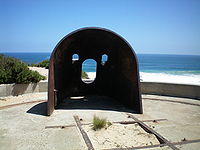
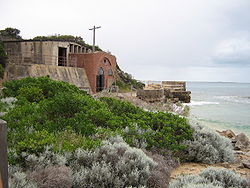
See also
- Fort QueenscliffFort QueenscliffFort Queenscliff, in Victoria, Australia, dates from 1860 when an open battery was constructed on Shortland's Bluff to defend the entrance to Port Phillip. The Fort, which underwent major redevelopment in the late 1870s and 1880s, became the headquarters for an extensive chain of forts around Port...
- Fort PearceFort PearceFort Pearce is a former defensive facility occupying part of Point Nepean, Victoria, Australia. It was part of a network of fortifications, commanded from Fort Queenscliff, protecting the narrow entrance to Port Phillip.-Fortifications:...
- South Channel FortSouth Channel FortSouth Channel Fort is a 0.7 ha artificial island in southern Port Phillip, Victoria, Australia, 6 km north-east of the town of Sorrento. It was part of a network of fortifications protecting the narrow entrance to Port Phillip....
- Swan Island
- Pope's EyePope's EyePope's Eye is the uncompleted foundation for an island fort intended to defend the entrance to Port Phillip in the state of Victoria, Australia. It is less than a kilometre south-west of the former Chinaman's Hat....
- Jervois-Scratchley reportsJervois-Scratchley reportsThe Jervois-Scratchley reports of 1877 concerned the defences of the Australian colonies, and influenced defence policy into the twentieth century. From the time of the first settlement in Australia, the Royal Marines, the New South Wales Corps and a succession of regiments of the British army had...

